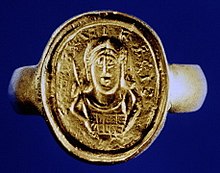
Theodoricthe Great, also called Theodoric the Amal, was king of the Ostrogoths (471–526), and ruler of the independent Ostrogothic Kingdom of Italy between 493 and 526, regent of the Visigoths (511–526), and a patrician of the Eastern Roman Empire. As ruler of the combined Gothic realms, Theodoric controlled an empire stretching from the Atlantic Ocean to the Adriatic Sea. Though Theodoric himself only used the title 'king' (rex), some scholars characterize him as a Western Roman Emperor in all but name, since he ruled large parts of the former Western Roman Empire, had received the former Western imperial regalia from Constantinople in 497, and was referred to by the title augustus by some of his subjects.

Year 405 (CDV) was a common year starting on Sunday of the Julian calendar. At the time, it was known as the Year of the Consulship of Stilicho and Anthemius. The denomination 405 for this year has been used since the early medieval period, when the Anno Domini calendar era became the prevalent method in Europe for naming years.
Year 431 (CDXXXI) was a common year starting on Thursday of the Julian calendar. At the time, it was known as the Year of the Consulship of Bassus and Antiochus. The denomination 431 for this year has been used since the early medieval period, when the Anno Domini calendar era became the prevalent method in Europe for naming years.
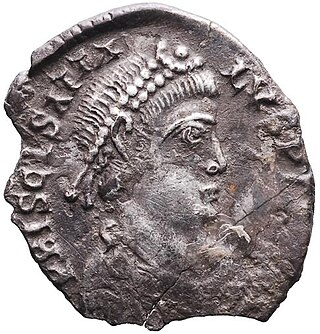
Year 409 (CDIX) was a common year starting on Friday of the Julian calendar. In the Roman Empire, it was known as the Year of the Consulship of Honorius and Theodosius. The denomination 409 for this year has been used since the early medieval period, when the Anno Domini calendar era became the prevalent method in Europe for naming years.

Year 415 (CDXV) was a common year starting on Friday of the Julian calendar. At the time, it was known as the Year of the Consulship of Honorius and Theodosius. The denomination 415 for this year has been used since the early medieval period, when the Anno Domini calendar era became the prevalent method in Europe for naming years.
The 460s decade ran from January 1, 460, to December 31, 469.

Year 455 (CDLV) was a common year starting on Saturday of the Julian calendar. At the time, it was known as the Year of the Consulship of Valentinianus and Anthemius. The denomination 455 for this year has been used since the early medieval period, when the Anno Domini calendar era became the prevalent method in Europe for naming years.

Year 459 (CDLIX) was a common year starting on Thursday of the Julian calendar. At the time, it was known as the Year of the Consulship of Ricimer and Patricius. The denomination 459 for this year has been used since the early medieval period, when the Anno Domini calendar era became the prevalent method in Europe for naming years.

Year 466 (CDLXVI) was a common year starting on Saturday of the Julian calendar. At the time, it was known as the Year of the Consulship of Leo and Tatianus. The denomination 466 for this year has been used since the early medieval period, when the Anno Domini calendar era became the prevalent method in Europe for naming years.

Year 534 (DXXXIV) was a common year starting on Sunday of the Julian calendar. At the time, it was known as the Year of the Consulship of Iustinianus and Paulinus. The denomination 534 for this year has been used since the early medieval period, when the Anno Domini calendar era became the prevalent method in Europe for naming years.

Year 540 (DXL) was a leap year starting on Sunday of the Julian calendar. In the Roman Empire, it was known as the Year of the Consulship of Iustinus without colleague. The denomination 540 for this year has been used since the early medieval period, when the Anno Domini calendar era became the prevalent method in Europe for naming years.

Year 474 (CDLXXIV) was a common year starting on Tuesday of the Julian calendar. At the time, it was known as the Year of the Consulship of Leo without colleague. The denomination 474 for this year has been used since the early medieval period, when the Anno Domini calendar era became the prevalent method in Europe for naming years.

Year 535 (DXXXV) was a common year starting on Monday of the Julian calendar. At the time, it was known as the Year of the Consulship of Belisarius without colleague. The denomination 535 for this year has been used since the early medieval period, when the Anno Domini calendar era became the prevalent method in Europe for naming years.
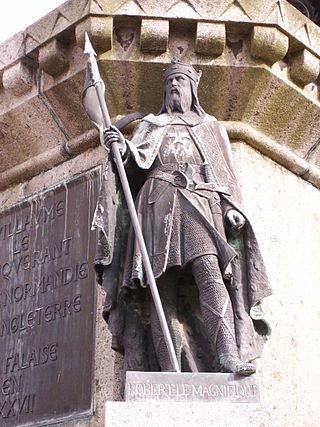
Year 1027 (MXXVII) was a common year starting on Sunday of the Julian calendar.

Thrasamund (450–523), King of the Vandals and Alans (496–523), was the fourth king of the north African Kingdom of the Vandals. He reigned longer than any other Vandal king in Africa other than his grandfather Genseric.
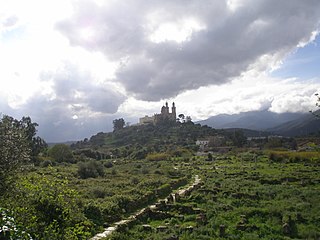
Year 435 (CDXXXV) was a common year starting on Tuesday of the Julian calendar. At the time, it was known as the Year of the Consulship of Theodosius and Valentinianus. The denomination 435 for this year has been used since the early medieval period, when the Anno Domini calendar era became the prevalent method in Europe for naming years.

Gesalic, Gesaleico in Spanish and Portuguese, Gesaleic in Catalan,, was a king of the Visigoths from 507 to 511, and died in 513.
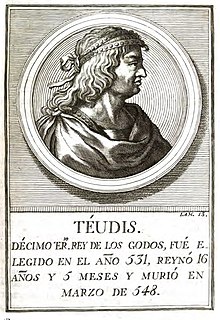
Theudis, was king of the Visigoths in Hispania from 531 to 548.
The Gutones were a Germanic people who were reported by Roman era writers in the 1st and 2nd centuries to have lived in what is now Poland. The most accurate description of their location, by the geographer Ptolemy, placed them east of the Vistula river.

The Sack of Rome on 24 August 410 AD was undertaken by the Visigoths led by their king, Alaric. At that time, Rome was no longer the capital of the Western Roman Empire, having been replaced in that position first by Mediolanum in 286 and then by Ravenna in 402. Nevertheless, the city of Rome retained a paramount position as "the eternal city" and a spiritual center of the Empire. This was the first time in almost 800 years that Rome had fallen to a foreign enemy, and the sack was a major shock to contemporaries, friends and foes of the Empire alike.
